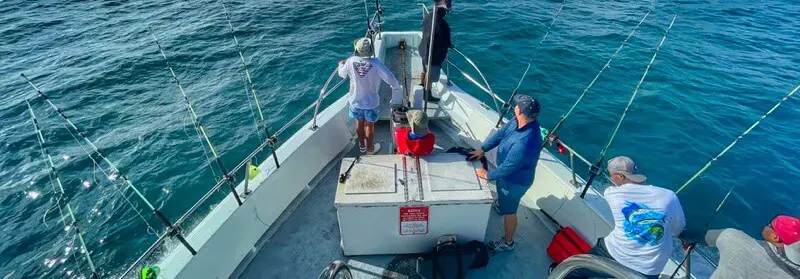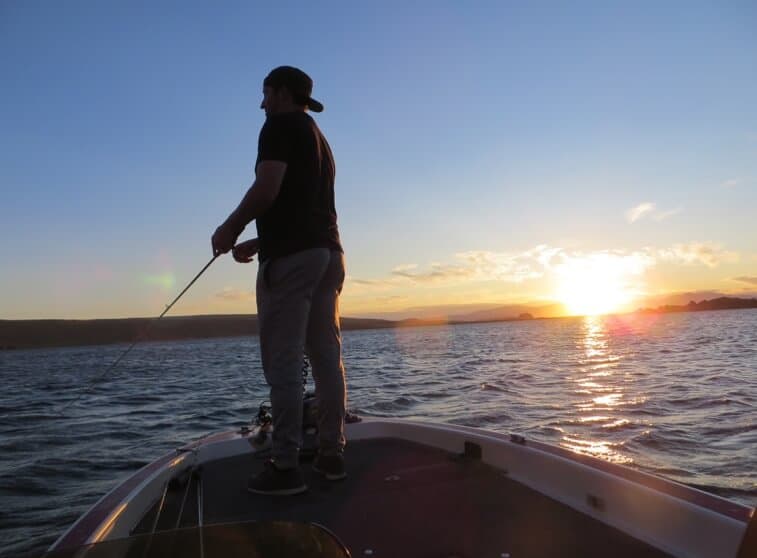We’ve all gotten ready for a perfect day of fishing, picked out your favorite fishing rod and lure, only to stare at your idling line without a single bite. The answer often lies in how weather affects your fishing. So today, we will focus on how wind affects your fishing and if it’s good or bad.
Southwest wind is good for fishing, but Northeast winds create poor fishing environments. Wind causes waves, currents, and barometric pressure changes that move food and baitfish to the shore, attracting larger feeding fish. However, wind makes casting and feeling bites more challenging.
The wind is a funny thing when it comes to fishing- it can be both good and bad. So, how does wind direction impact fishing?
What Causes Wind?
Yes, I know you aren’t reading this post to find out the definition of wind. Regardless, I need you to please bear with me. I have decided to add a small “what causes wind?” paragraph, hoping that it will simplify the good stuff (how wind impacts fishing).
So, the wind is the movement of air caused by the unevenness of the Earth caused by the sun. The wind is the great equalizer of the atmosphere. It transports heat, moisture, and dust around the Earth.
Wind travels at different speeds, at different altitudes, and over water or land, causing various weather patterns and storms.
We have jet streams that shift to the north during the summer, that pulls warm gusts of low-pressure air from the southwest. This is why we have warm summer winds. Whereas, during fall and winter, we experience jet streams shifting to the south, bringing cold fronts and high-pressure air masses from the north.
Storms start to brew when masses of cold and warm air mix.
How does Wind Impact Fishing?

Wind influences water bodies and their residents in various ways. Let’s look at the top ways wind impacts weather and, ultimately, fishing.
Wind Creates Waves
The most obvious way that wind impacts fishing is, of course, waves.
Wind creates friction as it blows along the surface of the water. As a result, the stronger the wind, the greater the friction, and the larger the waves.
The turbulence from the waves or ripples will significantly increase the amount of oxygen in the water too.
Wind Creates a Cover
As the waves or ripples deflect the sun, the wind acts as a cover for fish.
The wind can also turn a water source into a muggy, dirty space by stirring up the muddy bottoms. When the wind blows, the ripples cause the light to refract; and fish are more likely to be shallower in refracted light than bright light.
So, the wind creates movement that causes the fish to feed more during a current or wind.
Wind Acts as a Current
The wind and waves then follow to increase the turbidity of the water, acting as a current. When this occurs, the wind can be your best friend if you learn to use it correctly.
Wind acts as a current that swishes water around, breaking leaves off plants and ultimately moves the nutrients and food supplies (phytoplankton) to the banks, causing baitfish to move into the shore to eat the food supplies.
In turn, this causes the larger fish to move in too to position themselves to feed on the baitfish.
Wind Affects the Barometric Pressure
Lastly, wind causes a change in barometric pressure.
Barometric pressure, also known as atmospheric pressure, is the force exerted by the Earth’s atmosphere on a specific area. Simply put, try to think of it as “the weight of the air.”
If there’s one variable that can bring about a feeding frenzy in fish, it’s a change in barometric pressure!
Sudden weather changes produce rapid shifts in the barometric pressure- this is precisely why these are the best moments to wet your line.
As the atmospheric pressure pushes down on Earth’s surface, the same applies to its many bodies of water. In turn, these water pressures push on the fish that live there.
Why does Barometric Pressure have an Effect on Fish?
Fish have developed physical adaptations to survive. Two of the adaptations include the swim bladder and the lateral line.
Swim Bladder
The swim bladder is something like a natural barometer. It is an organ similar to the stomach, which has the ability to inflate with air, allowing the fish to achieve buoyancy. As a result, as the air pressure changes, so does the fish’s swim bladder.
Lateral Line
The lateral line is an organ fish have used to either navigate or sense the presence of food or predators. It senses the tiniest of repercussions in the water, and as such, it is susceptible to barometric pressure changes.
Does the Direction of the Wind Affect Fishing Differently?
The temperatures of the wind and the time of the year play a role in how wind affects fishing.
A north blowing wind in summer is very different than one blowing in the depth of winter. Similarly, a southwest wind will probably be wet and warm in summer but contrasting cold in winter.
Southwest winds are great feeding winds and perfect for catching fish during summer, but they seldomly create good conditions in the winter months.
Whereas fish are far less likely to move on a northeasterly breeze than a southwest wind.
How does Wind Positively Affect Fishing?
I’m assuming you’ve gotten the hint that wind is really good for fishing by reading the influences as mentioned earlier. So let’s look at some more positive effects wind may have on fishing:
- Wind causes waves that increase the amount of oxygen in the water.
- Wind creates a cover for fish.
- The wind blows insects and all sorts of vegetation into the water that the fish love to snack on.
- Wind creates currents that shift smaller baitfish towards that shoreline.
- The wind brings larger fish closer to the shoreline to feed.
How does Wind Negatively Affect Fishing?
Much can be said about windy conditions; some believe that wind improves fishing (which is mostly true); however, the wind has adverse side effects when fishing. Let’s look at them:
- Wind hampers with your casting accuracy.
- The wind turns water into a turbid watercolor, making it harder to see lures.
- Wind influences your ability to feel bites.
- And wind can overall be uncomfortable conditions to fish in.
- In severe wind, fish will often move to deeper waters for safety, making shoreline fishing close to impossible.
Other Fishing Resources
- Best Windy Day Bass Fishing Lures
- Can You Catch Fish During the Day?
- Bass Fishing in The Rain – Complete Guide
- How Weather Affects Fishing: All You Need to Know
- How Does Wind Direction Affect Fishing? (fishtackly.com)
Conclusion
In all, fishing in the wind is tricky and usually less than desirable, but the upside of fishing in the wind can be huge!
As we mentioned earlier, the wind is good or bad for fishing, depending on the wind’s direction.
Fishing in windy conditions is beneficial thanks to waves, currents, and barometric pressure that make conditions ideal. However, wind makes fishing difficult when you have the wrong fishing setup, location, and fishing gear.
Please remember, even though a bit of wind can be good for fishing, too strong wind is dangerous and will not do anybody any favors.
Tight lines!

